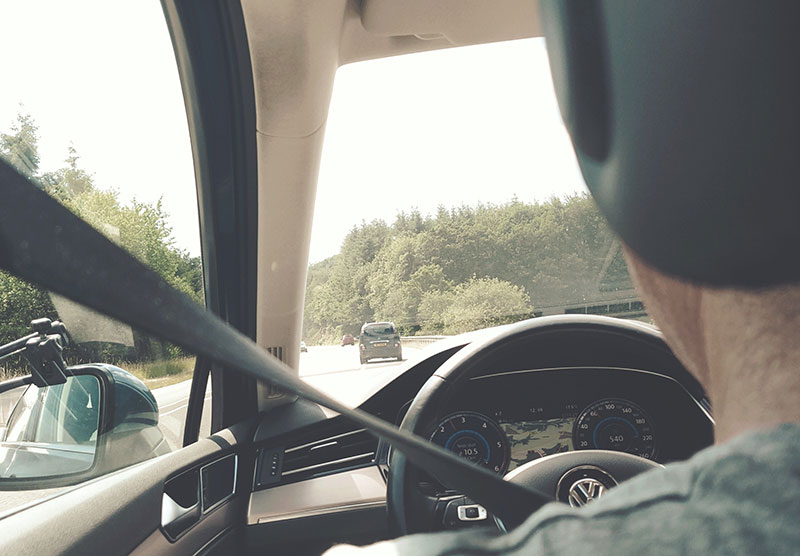Adults
Adults | 18 years +

The Top Five Things to Know About Buckling Up
Buckling up is the single most effective thing you can do to protect yourself in a crash.
From 2004 to 2008, seat belts saved more than 75,000 lives—enough people to fill a large sports arena. If you are completely thrown from a vehicle during a crash, it is almost always fatal. If you do survive, it’s gonna hurt. Buckling up keeps you safe and secure inside your vehicle and can save your life—and your face. Seat belts are the best defense against impaired, aggressive, drowsy and distracted drivers.
Air bags are designed to work with seat belts, not replace them.
Did you know that air bags open at a rate of 60 mph? If you are thrown directly into a rapidly opening air bag without any restraining help from your seat belt, the force could injure or even kill you. Seat belts are designed to work together with air bags—the seat belt secures the occupant and the air bag lessens the crash impact. Visit www.SaferCar.gov for more information on air bag safety.
Know how to buckle up properly.
The lap belt and shoulder belt are secured across the hip bones, across the chest and positioned at mid shoulder; these bones are more equipped to withstand crash forces than other parts of your body. Wearing BOTH your lap and shoulder belt is the best line of defense.
- The head restraint should lie somewhere between the top of your ears and the top of your head.
- Place the shoulder belt across your shoulder bone, down the middle of your chest and away from your neck.
- Adjust the lap belt across your hips below your stomach.
- NEVER put the shoulder belt behind your back or under your arm.
Fit matters.
- Before you buy a new car, check to see that its seat belts are a good fit for you.
- If you’re short, ask your dealer about seat belt adjusters, which can help you get the best fit.
- If you need a roomier belt, contact your vehicle manufacturer to obtain a seat belt extender.
- If you drive an older or classic car with no seat belts or lap belts only, check with your vehicle manufacturer about how to update your car with today’s safer lap/shoulder belts.
Occupant protection is for everyone.
Click it, Utah. Every one, every trip.
Adults | 18 years +
Proper Fit
The top five things to know about buckling up:
Buckling up is the single most effective thing you can do to protect yourself in a crash.
From 2004 to 2008, seat belts saved more than 75,000 lives—enough people to fill a large sports arena. If you are completely thrown from a vehicle during a crash, it is almost always fatal. If you do survive, it’s gonna hurt. Buckling up keeps you safe and secure inside your vehicle and can save your life—and your face. Seat belts are the best defense against impaired, aggressive, drowsy and distracted drivers.
Air bags are designed to work with seat belts, not replace them.
Did you know that air bags open at a rate of 60 mph? If you are thrown directly into a rapidly opening air bag without any restraining help from your seat belt, the force could injure or even kill you. Seat belts are designed to work together with air bags—the seat belt secures the occupant and the air bag lessens the crash impact. Visit www.SaferCar.gov for more information on air bag safety.
Know how to buckle up properly.
The lap belt and shoulder belt are secured across the hip bones, across the chest and positioned at mid shoulder; these bones are more equipped to withstand crash forces than other parts of your body. Wearing BOTH your lap and shoulder belt is the best line of defense.
- The head restraint should lie somewhere between the top of your ears and the top of your head.
- Place the shoulder belt across your shoulder bone, down the middle of your chest and away from your neck.
- Adjust the lap belt across your hips below your stomach.
- NEVER put the shoulder belt behind your back or under your arm.
Fit matters.
- Before you buy a new car, check to see that its seat belts are a good fit for you.
- If you’re short, ask your dealer about seat belt adjusters, which can help you get the best fit.
- If you need a roomier belt, contact your vehicle manufacturer to obtain a seat belt extender.
- If you drive an older or classic car with no seat belts or lap belts only, check with your vehicle manufacturer about how to update your car with today’s safer lap/shoulder belts.
Occupant protection is for everyone.
Click it, Utah. Every one, every trip.
